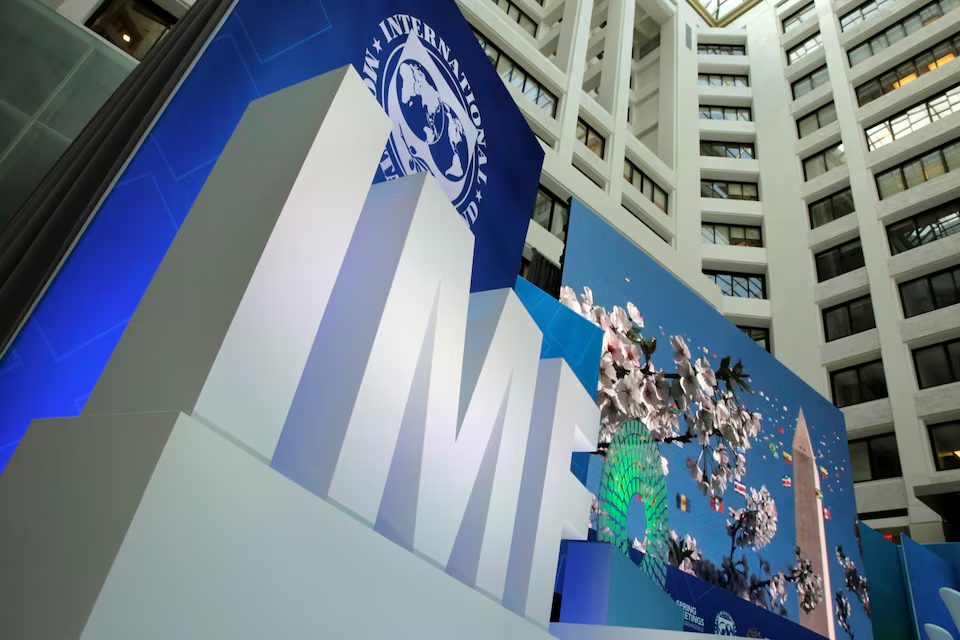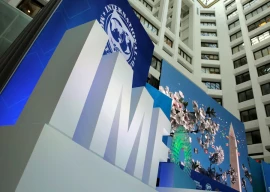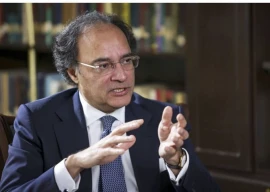
The International Monetary Fund (IMF) has clubbed Pakistan among six nations facing serious conflicts this year and said that conflicts and tight macroeconomic policy conditions would have a toll on their economic outputs.
Separately, Finance Minister Muhammad Aurangzeb met with IMF Managing Director Kristalina Georgieva in Washington on Wednesday. The minister showed Pakistan’s interest in seeking another long-term bailout package. The finance ministry has remained tight-lipped about the meeting.
However, IMF’s Middle East and Central Asia Director Jihad Azour later told reporters that the Fund was ready to support Pakistan and stressed that the package of reforms was now more important than the size of the new program.
"I think what is important at this stage is to accelerate the reforms, double down on the structure of reforms in order to provide Pakistan with its full potential of growth," Azour told a press conference on the sidelines of the IMF 2024 spring meetings.
Earlier on Thursday, in its report on the Middle East and Central Asia region, the IMF said that the economic forecast for 2024 had been revised down to 2.6% for the region as conflicts, tight policy settings in some economies, and lower hydrocarbon production continued to weigh on growth.
“Beyond West Bank and Gaza, six economies in MENA [Middle East and North Africa] and Pakistan faced conflicts at the beginning of 2024. These are Iraq, Pakistan, Somalia, Sudan, Syria, and Yemen,” read a footnote to the report, released on the sidelines of the World Bank-IMF spring meetings.
Bracketing Pakistan with countries that are facing serious conflicts, including civil wars, may not bode well for the country’s global image and could contribute to hampering investment. This shows the poor handling of the IMF affairs by the finance ministry.
The IMF stated in the report that a country was considered to be in a conflict if at least 25 battle-related fatalities were recorded by the Armed Conflict Location and Event Data Project between January 1, 2024, and March 8, 2024.
There has been an increase in the number of terrorist attacks on the civil and armed forces of the country, including a fatal attack on the Chinese nations, which resulted in the deaths of five Chinese citizens last month.
The report stated that the conflict in Gaza and Israel had worsened an already challenging environment, and disruptions to shipping through the Red Sea had added to uncertainty. However, it added that economic growth was projected to strengthen as the impact of oil production cuts and conflicts gradually faded while remaining below historical averages over the medium term.
The report underlined that the economic growth outlook for the region and Pakistan was characterized by an uneven recovery against a backdrop of armed conflicts, hydrocarbon dependence, and persistent structural challenges.
It said that after contracting in 2023, growth in Pakistan was projected to rebound to 2% in 2024, supported by continuing positive base effects in the agriculture and textile sectors.
Pakistan’s population growth rate was 2.6% and a low growth rate of 2% meant more unemployment and poverty in the country that had been hit the hardest by the continued wave of inflation.
Despite tight economic conditions, the IMF again advised Pakistan to keep its monetary policy strict –a policy that had already taken a heavy toll on the industrial output and the government’s budget.
“Where inflationary pressures persist, monetary policy should remain tight and follow a data-dependent approach like in Egypt, Kazakhstan, Pakistan, Tunisia, Uzbekistan, while closely monitoring risks of a reversal of inflation developments.”
Pakistan’s inflation rate slowed down to 20.7% in March, which the analysts said, had created the room for a cut in the interest rates. However, the IMF still advised a precautionary path. “If inflation moderates faster than expected, countries should carefully monitor developments and stand ready to ease monetary policy sooner if conditions allow,” said the global lender.
In its World Economic Outlook report, the IMF adjusted Pakistan’s inflation forecast upward to 24.8% for this fiscal year and 12.7% for the next fiscal year. Contrary to the government’s drumming of achieving external sector stability, the IMF said that Pakistan’s external sector buffers had deteriorated.
“Pakistan’s external buffers deteriorated, mostly reflecting ongoing debt service, including Eurobond repayments,” the IMF said. It added that the credit risk of many countries had narrowed over the past year and was close to early 2023 levels but “they remain at distressed levels [more than 1,000 basis points] for Lebanon, Pakistan, and Tunisia”.
The global lender said that the continued reliance on domestic financing risked further exacerbating the sovereign-bank nexus, given the already high exposure of banks to sovereign debt in Egypt and Pakistan.
The banks had on average invested about three-fourths of their balance sheets in the government debt, according to the World Bank report. There might be no let-up in the higher borrowing requirements, as the IMF had also projected 7.3% of the GDP budget deficit for the next fiscal year.
For the past four days, the rupee had again started shedding the value against the US dollar, albeit at a slow pace. In an interview with Bloomberg in Washington, Finance Minister Muhammad Aurangzeb said there should be no reason for the rupee to depreciate more than the range of about 6% to 8% seen in a typical year.
However, what the finance minister described as a normal deprecation of 6% to 8% in a typical year means a devaluation of Rs17 to Rs23 per dollar in the value of the rupee. If one goes by the finance minister’s reading of the value, the rupee should be over Rs300 to a dollar in the next fiscal year.



























COMMENTS (1)
Comments are moderated and generally will be posted if they are on-topic and not abusive.
For more information, please see our Comments FAQ